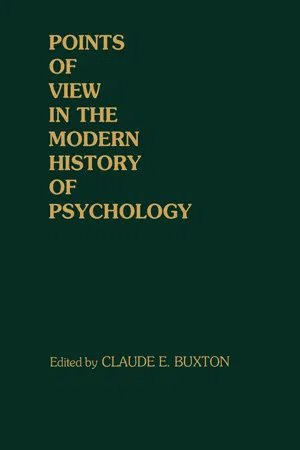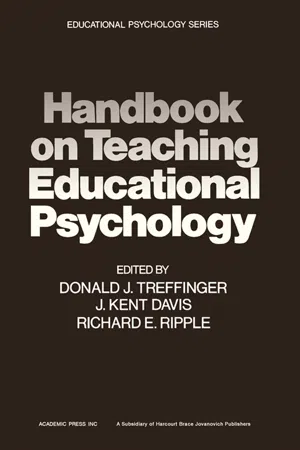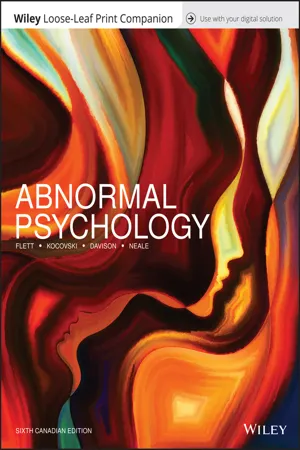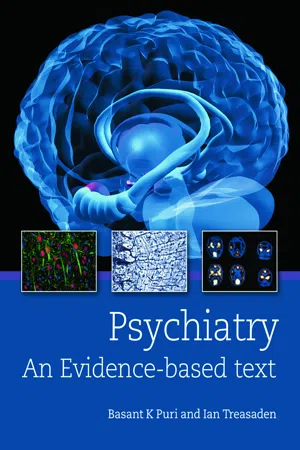Psychology
Psychological Perspectives
Psychological perspectives refer to the different approaches and theories used to understand and explain human behavior and mental processes. These perspectives include biological, cognitive, behavioral, psychodynamic, humanistic, and sociocultural viewpoints, each offering unique insights into the complexities of the human mind and behavior. By considering these diverse perspectives, psychologists can gain a more comprehensive understanding of human psychology.
Written by Perlego with AI-assistance
Related key terms
1 of 5
7 Key excerpts on "Psychological Perspectives"
- Lorelle J. Burton, Drew Westen, Robin M. Kowalski(Authors)
- 2022(Publication Date)
- Wiley(Publisher)
In this chapter and throughout the text, we examine five perspectives that guide current psychological thinking, offering sometimes competing and sometimes complementary points of view. These perspectives offer the same kind of broad, orienting approach as a scientific paradigm, and they share its three essential features. Focusing on these perspectives does not mean that other less comprehensive approaches have not contributed to psychological knowledge or that nothing can be studied without them. These five perspectives generally guide psychological investigations and therapeutic interventions. APPLY AND DISCUSS • To what extent has integration between the different theoretical perspectives occurred? • What are the main benefts of an approach that accepts many behaviourist principles but also emphasises the role of thought processes in learning? In the following sections, we examine the psychodynamic, behaviourist, humanistic, cognitive and evolutionary perspectives. In many respects, these perspectives have evolved independently, and at the centre of each are phenomena the others tend to ignore. INTERIM SUMMARY A paradigm is a broad system of theoretical assump- tions employed by a scientifc community that includes a distinct set of concepts or thought patterns, and shared metaphors and research methods. Psychology lacks a unifed paradigm but has a number of schools of thought, or perspectives, that can be used to understand psycho- logical events. The psychodynamic perspective A friend has been going out with a man for five months and has even jokingly tossed around the idea of marriage. Suddenly, her boyfriend tells her he has found someone else. She is shocked and cries uncontrollably but a day later declares that ‘he didn’t mean that much to me anyway’.- Claude E. Buxton(Author)
- 2013(Publication Date)
- Academic Press(Publisher)
Even so, a reader may be justified in feeling that context has not been emphasized enough. We turn now to some summary ideas in the contextual history of psychol-ogy, although it would be enormously presumptuous to imply that in a few additional pages we can do more than suggest an orientation to the study of such influences. 420 Claude Ε. Buxton Themes Related to Psychology's History In the nineteenth century and earlier, most of the context of our his-tory is to be found in three sources, each with a prevailing theme. First in time, and frequently (but not always) in importance, were philosophi-cal views and arguments. These were mentioned in Chapters 1, 4, and 13. A second kind of context was provided by biological science in two lines of influence—the physiological (mainly neurophysiological) and the evolutionary. Chapter 12 is, of course, witness to the compelling influences of biology on psychology's history, as are Chapters 2 and 3. Chapters 4 and 5 suggest its bearing on the very definition of early scientific psychology, while the sometimes strained relations of psycho-analysis and biology are apparent in Chapters 8 and 9. The third context, not discussed much previously but not to be overlooked, comprises the powerful influences of religion and theology. Of all the social and cul-tural influences we might touch on here, these are discussed (rather briefly) now because they tended especially to be directive in mental philosophy as it pertained to human nature, and in biology they under-lay the resistance to evolutionary doctrine. We do not include political, economic, and other contexts. THE PHILOSOPHICAL CONTEXT Philosophy has always had many facets, of course, but the one most important to the history of psychology was usually called moral or men-tal philosophy.- eBook - PDF
- Nancy Ogden, Michael Boyes, Evelyn Field, Ronald Comer, Elizabeth Gould(Authors)
- 2021(Publication Date)
- Wiley(Publisher)
As we discussed back in Chapter 4, psychologists and biologists have come to acknowledge that environmental experience and biological mechanisms work together to shape personality. In this chapter, we will first explore key historic perspectives on the “why” question in personal- ity: the psychodynamic, humanistic, trait, situationist, and interactionist perspectives. We then look at the important role played by genetic predispositions in personality and what researchers have discovered about the contributions of both genetic and environmental factors. Next, we examine how personality is assessed in individuals and whether personality differs depending on gender and culture. And finally, we describe various personality disorders. The Psychodynamic Perspective LEARNING OBJECTIVE 1 Summarize the main ideas of the psychodynamic view of personality development. As you read in Chapters 1 and 6, the psychodynamic (or psychoanalytic) model emphasizes the unconscious, often dark desires that have to be held in check. Recall also from those chap- ters that the model was formulated by the Viennese neurologist Sigmund Freud (1856–1939) personality the unique charac- teristics that account for enduring patterns of inner experience and outward behaviour. The Psychodynamic Perspective 491 at the beginning of the twentieth century. Freud, like his contemporary Charles Darwin (Mon- cayo, 2018), believed that a full account of human psychology and personality needed to include acknowledgement that humans, like other animals, have some basic wired-in drives of instincts. In Freud’s broadly cast efforts to address the “why” question, the personality forms as a result of struggles between primal needs and social or moral restraints. Many other theorists who follow Freud’s key principles differ from him in certain ways. However, they share his basic notion that personality and behaviour are shaped by interacting, or dynamic, underlying forces. - Dominic Upton(Author)
- 2013(Publication Date)
- Routledge(Publisher)
Differences between the dissatisfied CBT and PDT patients: Both patients experienced major problems in their relations to the therapists, but in different ways: CBT patients considered the therapist to be intrusive and oppressive; PDT patients felt the therapist was withdrawn, disengaged. The CBT patients were very disappointed and negative whereas the PDT patients were ambivalent.ImplicationsDissatisfied patients should be identified and asked about the reasons for their feeling and advised to try some other type of psychotherapy or another therapist who may better meet their needs and complaints.2.22 SummaryPsychological approaches to the person attempt to explain why people behave in a certain manner. Understanding the person requires an appreciation of a number of Psychological Perspectives. The psychodynamic approach explores how the unconscious mind is responsible for behaviour. Freud’s psychoanalytic approach suggests behaviour is a result of an interaction between innate drives and early experiences in childhood. According to Freud, the mind has three levels: the conscious, pre-conscious and unconscious. Freud also assumed that the mind could be divided into three basic sections the id (innate), ego (reality) and superego (morals). The ego protects itself by a number of defence mechanisms. Freud’s ideas have fallen out of favour or have been adapted to incorporate more social rather than sexual influences. A criticism of Freudian and other psychodynamic theories is that they do not translate into measurable observations and are therefore untestable. According to behaviourists, all behaviour is learnt from the environment (to the near exclusion of innate or inherited factors). Early behaviourist theories suggest that learning and behaviour are the result of conditioning (classical or operant). The focus of the behavioural approach is on the patient’s behavioural symptoms rather than on the underlying causes of the behaviour itself. - eBook - PDF
- Donald J. Treffinger, J. Kent Davis, Richard E. Ripple, Donald J. Treffinger, J. Kent Davis, Richard E. Ripple(Authors)
- 2013(Publication Date)
- Academic Press(Publisher)
It enables us to focus on the human meanings, human understandings, and human experiences involved in growth, teaching, and learning. The view of human behavior that grows out of a humanistic framework is one which focuses on how persons, in a social context, are influenced and guided by the personal meanings they attach to their experiences. It is a psychological stance that focuses not so much on persons' biological drives, but on their goals; not so much on stimuli impinging on them, but on their desires to be or to do something; not so much on their past experiences, but on their current circum-stances; not so much on life conditions per se, but on their perceptions of those conditions. Hence, the emphasis is on the subjective qualities of human experience, the personal meaning of an experience to persons, rather than on their objective, observable responses. Humanistic psychology, then, is composed of all those currents of psychologi-cal thought in which human behavior is viewed somewhat as each individual views him—or herself—that is, as a person rather than as an animal or a machine. Humanistic Psychology 141 BASIC HUMANISTIC CONCEPTS James F. T. Bugental, the first president of the American Association for Humanistic Psychology when it was formed in 1962, identified the goal of humanistic psychology as The preparation of a complete description of what it means to be alive as a human being [1967, p. 7]. In another source, Bugental (1965, pp. 11-12) has suggested five basic postulates for a humanistic perspec-tive of human behavior, which may help give additional meaning to this point of view. 1. Man, as man, supersedes the sum of his parts. I suppose you could say that this is something like concluding that Bernstein's score for West Side Story is more than the summation of the number of musical notes that went into compos-ing it. - eBook - PDF
- Gordon L. Flett, Nancy L. Kocovski, Gerald C. Davison, John M. Neale(Authors)
- 2018(Publication Date)
- Wiley(Publisher)
Rather, as suggested by philosopher of science Thomas Kuhn (1962), subjective factors as well as limitations in our perspec- tive on the universe enter into the conduct of scientific inquiry. Central to any application of scientific principles, in Kuhn’s view, is the notion of paradigm, the conceptual framework or approach within which the scientist works. A paradigm is a set of basic assumptions that outline the particular universe of scientific inquiry. It has profound implications for how scien- tists operate, for “[people] whose research is based on shared paradigms are committed to the same rules and standards for scientific practice” (Kuhn, 1962, p. 11). Paradigms specify what problems scientists will investigate and how they will go about the investigation. Paradigms are an intrinsic part of a science, serving the vital function of indicating the rules to be followed. A paradigm injects inevitable biases into the definition and collection of data and may also affect the interpretation of facts. In other words, the meaning or import given to data may depend to a considerable extent on a paradigm. In this chapter, we will describe the major paradigms of abnormal psychology and provide an idea of how they operate. We first present four major types of paradigms: biological, cognitive-behavioural, psychoanalytic, and humanistic. The psychodynamic and humanistic paradigms have become less influential over the years, but have some modern applications and themes that continue to have a significant impact. 2.2 The Biological Paradigm 33 Contemporary Approaches to the Biological Paradigm More sophisticated approaches are used today, of course, and there is now an extensive literature on biological factors relevant to psychopathology. - eBook - PDF
- Bassant Puri, Ian Treasaden(Authors)
- 2009(Publication Date)
- CRC Press(Publisher)
However, just how the underlying motives are conceptualized and investi-gated depends very much on the persuasion of the psychol-ogist. For example: ● A psychodynamic psychologist will try to discover inter-nal, unconscious drives and motives (see Chapter 19 for a discussion of Freud’s psychoanalytical theory). ● A behaviourist psychologist will look for environmental schedules of reinforcement, which can explain the behaviour of rats and pigeons as effectively as that of human beings (see Chapter 14). As a radical behaviourist, Skinner rejects the claim that mental or other internal events or processes – conscious or unconscious – can influence behaviour in any way. For him, ‘motivation’ and other mentalistic terms are ‘explanatory fictions’. ● A humanistic psychologist, such as Maslow, will try to understand a person’s behaviour in terms of a hierarchy of motives, with self-actualization at the top of the hierarchy. ● For a biopsychologist , what is crucial are bodily events and processes taking place in the central nervous system (CNS), the autonomic nervous system (ANS) and the endocrine system, or interactions between these differ-ent systems. These events and processes are related to the biological survival of the person or animal. Although we shall consider a range of different motives, this chapter has a very ‘biological’ flavour. Maslow’s hierar-chy of needs is useful as a general framework for examining other approaches. Homeostatic drive theories try to explain hunger and thirst. But even in the case of such basic bio-logical motives as these, cognitive and other individual fac-tors, as well as social, cultural and other environmental factors, play a crucial role. We shall also consider non-homeostatic needs and drives, including electrical self-stimulation of the brain (ES-SB), competence and cognitive motives, and some important social motives.
Index pages curate the most relevant extracts from our library of academic textbooks. They’ve been created using an in-house natural language model (NLM), each adding context and meaning to key research topics.






